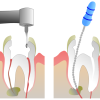dental infections are often dangerous. It is necessary to avoid a dental infection by preventive measures ,a Routine dental check up can detect the probable cause of infection and can be prevented . It is mandatory for patients with diabetes to remove all focus of infection as the spread of infection is some times fatal .see the report.
Necrotizing fasciitis in association with Ludwig\’s angina – A case report
A.M. Kavarodi *
Oral and Maxillofacial Surgery, King Fahd Military Medical Complex, Dhahran, Saudi Arabia
Keywords
Necrotizing fasciitis; Ludwig\’s angina
Abstract
A 28 year old male diabetic patient developed Ludwig\’s angina which subsequently evolved into cervicofacial necrotizing fasciitis. The differential characteristic of Ludwig\’s angina and cervicofacial necrotizing fasciitis, as it relates to this rare presentation is discussed. The clinical and radiological features, pathophysiology, diagnosis and the management that resulted in a successful outcome are presented.
1. Introduction
Ludwig\’s angina and necrotizing fasciitis (NF) are the two aggressive manifestations of soft tissue infection to occur in the cervico-facial region. In Ludwig\’s angina the pathogenic polymicrobial flora results in an aggressive form of cellulites while in the latter condition the hallmark is progressive suppu- rative fasciitis and cutaneous necrosis. Extreme systemic toxic- ity and rapid spread through the fascial spaces occur in both the conditions. Nevertheless the two conditions represent completely different pathogenic mechanisms; for this reason, the occurrence of both conditions in the same patient is rare and creates diagnostic dilemma at the onset of the disease.
Two factors, the characteristics of the polymicrobial flora and anatomy peculiar to the region bounding the mandible, combine to produce Ludwig\’s angina. For the same reason this condition is unique to the oro-facial region. It is an oro-facial cellulite which spreads rapidly through fascial spaces, but causing minimal destruction. Hence has the potential for rapid resolution when the infection is controlled. The immune status of the patient is of less importance in the initiation of this condition but certainly is a factor, which determines prognosis. The virulence of the organisms and the regional anatomy appears to play a greater role in the initiation and progression of Lud- wig\’s angina. On the other hand cervicofacial NF is rare, and usually occurs as a complication in patients who are immuno- compromised. Once initiated, the disease progresses rapidly through contiguous facial spaces causing necrosis of fascia and the overlying skin which is the hallmark of this condition. Necrosis of muscle, gland tissue and bone can also lead to considerable destruction (Salins et al., 1996). In most cases management of this condition requires not only control of the infection and physical spread of the infectious process but also major reconstructive procedures. The paper presents a case of Ludwig\’s angina in a young diabetic, which later presented in the form of NF.
2. Case report
A 28-year-old male presented to the out-patient maxillofacial clinic of Hamad Medical Corporation, Doha, Qatar with recurrent pericoronitis in relation to an impacted lower right third molar which was extracted under local anesthesia. After eight days the patient reported to emergency department with an extensive brawny swelling involving whole of the lower face and upper neck along with severe dysphagia and trismus. He had noticed a diffuse tender swelling over the right cheek five days after the extraction, which had gradually increased in size to involve both sides of the face and neck.
An extensive tender brawny swelling of bilaterally involving submandibular and submental regions, and elevation of the floor of the mouth was evident. The skin over the cervical region appeared edematous and board like on palpation with no areas of fluctuancy.
He was pyrexic with a temperature of 38.5 0C, having a pulse rate of 86 per minute and blood pressure 140/70 mm Hg. His oxygen saturation in the sitting posture was only 94% with effort.
An elevated leukocyte count, hemoglobin level of 14.2 gm/ dl, hematocrit of 52% and the fasting blood sugar level of 19 mmol/l were recorded.
Empirical intravenous antibiotic therapy was started with cephalosporine and metronidazole. Management of the elevated blood sugar was achieved by a standard sliding scale with an initial administration of 12 units of actrapid.
Under general anesthesia multiple incisions and drainage of the involved spaces of both sides were achieved. This consisted of two intra oral and two extra oral incisions on either side. Only minimal amount of fluid which appeared serous and not frankly pus like could be expressed. Multiple through Q1 and through drains were placed (Fig. 1). Post operatively he was managed in surgical intensive care unit and extubated after two days.
On fourth post op day evening the pyrexia had resolved and the mouth opening had returned to normal and he was able to manage a normal diet. On the fifth day the drains of the upper neck were removed and the drains of the lower neck were replaced. On the afternoon of the sixth day the patient complained of chills. The temperature had risen again to 38.4 0C. The culture of the pus sample taken from the drain site on the fourth day when received showed a predominant culture of Streprococci and Staphylococcus aureus. According to the sensitivity study the antibiotic was left unchanged.
A matter of considerable concern was the observed drop in hemoglobin level, which worsened to 6 gm/dl. Patient complained of severe pain over the neck and tenderness of the lower neck. Blood chemistry at this time showed hypocalcaemia (1.8 mmol/l) and a fall in the serum albumin level from 30 to 18 mmol/l hence decided to transfuse 2 units of packed cells and human albumin. Multiple spikes of temperature and an increase of foul smelling straw colored discharge from the lower neck were noted. The pus culture taken on sixth day showed profuse growth of streptococci along with S. aureus and the antibiotic changed into third generation cephalosporins as per the sensitivity study.
On the eighth day a dusky erythematous area developed in the right lower neck. Subsequently a grayish black ill defined fast spreading necrotic area was noted centrally. Bits of necro- tic fascia extruded from the draining sinuses. This was subjected to histopathology study. The dusky area extended to involve whole of the lower neck within 24 h. Multiple bullae and small blisters were also noted surrounding the necrotic area.
A CT study showed multiple air pockets in the tissue spaces of neck and the MRI gave evidences of extensive dead spaces with air locules and fluid collections in different levels of tissue planes. However, involvement of the mediastinum was ruled out.
A clinical diagnosis of NF was made and the patient was taken for immediate debridement exposing the contents of the neck and packed open with BIPP dressing. Extensive necrosis of the fascia was extending from the lower neck up to the mylohyoid line at the lingual surface of the mandible, undermining through the subcutaneous fascia (Fig. 2). Patient shifted to intensive care unit post operatively. The clinical picture, CT and MRI findings along with histological study confirmed the diagnosis of NF.
Patient showed marked improvement within 48 h and discharged home after five days.
3. Discussion
Delay in diagnosis of NF and its differentiation from similar looking infections will affect the prognosis and in turn the late surgical intervention may increase the morbidity. In recent times Ludwig\’s angina is primarily managed by antibiotic therapy and only nonresponsive cases may necessitate a surgical intervention (Nakamori et al., 2004). Association of Ludwig\’s angina and NF creates a diagnostic dilemma as an early intervention is necessary for better prognosis.
Ludwig\’s angina, first detailed by the German surgeon Wil- helm Friedrich von Ludwig in 1836 is a rapidly progressive, potentially fulminant cellulitis involving bilaterally the sub- mandibular, sub-mental and sub-lingual spaces (Nakamori et al., 2004). It typically originates from an infected or recently extracted tooth, most commonly the lower second and third molars. Ludwig\’s angina begins as a mild infection and can rapidly progress to brawny bilateral indurations of the upper neck with pain, trismus, and tongue elevation.The pathophysiology of Ludwig\’s angina, a deep-seated infection manifested with extensive cellulites, is not known to produce tissue necrosis. However, similar looking lesions like erysipelas, progressive bacterial synergistic gangrene, anaerobic streptococcal gangrene and gas gangrene (Persaud et al., 2004) are most often prone to induce necrosis.The initiating factors attributed to the NF varies from minor trauma (Barakate et al., 2001) serious infections (Krishnaraj et al., 2008) as per the site involved (Barakate et al., 2001; Brett Fugitt et al., 2004). However, the dental origin is the prime factor in cervical necrotizing fasciitis (CNF) (Krishnaraj et al., 2008).All authors agree on the association illness like diabetes mellitus in most reported cases of cervico fascial NF. The immune compromise is the principal deciding factor in the establishment and in the course and prognosis of the disease. However, this not a deciding factor in the usual presentation of Ludwig\’s angina.The localized necrosis in NF is secondary to the thrombosis of the nutrient vessels-interruption of its deep blood supply (Persaud et al., 2004), which in turn progress to show the classic pathognomonic sign of the NF; this is a dusky discoloration of the affected skin appearing as small purplish patch., which most often surrounded by blisters and bullae (Barakate et al., 2001). In this case the first sign of the dusky necrotic area was noticed six days after the initial drainage for Ludwig\’s angina. This was associated with rapid drop in hemoglobin, hypoalbuminemia and the hypocalcaemia.In cellulites infection begins at the junction between the der- mis and superficial fascia but in NF it starts at the level of subcutaneous fat and deep fascia and the epidermal dermal layers are spared in early stage. Pain in the absence of clinical changes is the usual presentation of early stages of NF as we noticed in this case. The pain was severe during the seventh and eighth hospital day. In cellulites tenderness and the pain is mainly inflammatory origin which persists till the pressure effects are released .Where in NF the thrombosis of the vessels to the skin initiate necrosis (Krishnaraj et al., 2008). The pain fades and paresthesia develops in the region when the nerves die eventually. Therefore, anesthesia is evident in most necrotic area where the surrounding area remains very tender (Tang et al., 2001).Different etiologic microorganisms reported in different series of NF. In the past hemolytic streptococci was believed to be the main causative organism. Now the picture has changed to a poly microbial infection which included gram negative bacilli, bacteriodes, diphtheriodes, and other synergistic anaerobic organisms.Streptococci were isolated in this case in the early stage of the decease and the early clinical presentation of Ludwig\’s angina. Even though the signs of pan cervical cellulites subsided after four days, a complete resolution of infection was not attained. Severe tenderness, spikes of temperature, hypocalca- emia, drop in hemoglobin and the increase of purulent discharge from the drain on the sixth day initiated further investigation to confirm the necrotizing fasciitis. Regular culture and sensitivity tests did not reveal any possibility of super- added nosocomial infection.A hyper intense signal on a T2 weighted spin echo MR signal at the deep fascial plane was considered by to be pathogno- monic of necrotizing fascitis (David et al., 2009) and the NF can be excluded in the absence of these findings. Liquefaction tissue necrosis and inflammatory edema both contribute to the accumulation of fluid in the fascia (David et al., 2009). The presence of soft tissue gas dissecting along the tissue planes is characteristic finding of the NF. The gas in NF is usually produced by anaerobic bacteria interacting with aerobic bacteria (David et al., 2009). This finding was evident in CT done and was supported by the MRI findings where the hyper intense signal on T2 weighted images of the lower neck confirmed the diagnosis.On the other hand Ludwig\’s angina remains a potentially life-threatening condition mainly because of the risk of impending airway obstruction. However, the mortality is reduced considerably in the present era of advanced anesthetic techniques. Ludwig\’s infection is not associated with any mortality in recently reported groups where the NF shows as high as 50% (Jee Hyun et al., 2009). Surgical drainage was once universally required as treatment for Ludwig\’s angina but now may be reserved for cases where antibiotic treatment fails.We conclude that both Ludwig\’s angina and NF are extensive manifestations of soft tissue infection to occur in the cerv- ico-facial region. Ludwig\’s Angina results in an aggressive form of cellulites while the latter manifest with progressive suppurative fasciitis and cutaneous necrosis. Early differentiation between the two similar clinical entities is the key to change the management strategy. High mortality and morbidity associated with lately diagnosed NF demand its early detection and differentiation from other similar clinical presentations. Investigations including CT, MRI and frozen section along with the characteristic clinical presentation will help in early recognition of this fatal condition even in the association of other serious infected states.
References
Barakate, M.S., Jensen, M.J., Hemli, J.M., Graham, A.R., 2001. Ludwig\’s angina: report of a case and review of management issues. Ann. Otol. Rhinol. Laryngol. 110, 453-456.
Brett Fugitt, J., Puckett, Michael L., Quigley, Michael M., Kerr, Stewart M., 2004. Necrotizing fasciitis. RadioGraphics 24, 14721476.
Birnbaum, David J., D\’Journo, Xavier Benoit, Casanova, Dominique, Thomas, Pascal A., 2009. NF of the chest wall Interact. Cardio- Vasc. Thorac. Surg. 10, 483-484.
Jee Hyun, Seok et al., 2009. NF versus pyomyositis: discrimination with using MR imaging. Korean J. Radiol. 10, 121-128.
Subhashraj, Krishnaraj, Jayakumar, Naveen, Ravindran, Chinnasam- y, 2008. Cervical NF: an unusual sequel of odontogenic infection. Med. Oral. Patol. Oral. Cir. Bucal. 1 13 (12), 788-791.
Nakamori, Y., Fujimi, S., Ogura, H., Kuwagata, Y., Tanaka, H., Shimazu, T., Ueda, T., Sugimoto, H., 2004. Conventional open surgery versus percutaneous catheter drainage in the treatment of cervical NF and descending necrotizing mediastinitis. AJR Am. J. Roentgenol. 82, 1443-1449.
Persaud, R., Krahe, D., Georgalas, C., Kaniyur, S., Das, S., Alusi, G., 2004. Life-threatening NF of the neck: an unusual consequence of a sore throat. Ann. R. Coll. Surg. Engl. 86, 253-257.
Salins, P.C., Saxena, J.K., John, J.K., 1996. Reconstruction of mandible and surrounding soft tissues in patient with NF. Int. J. Oral Maxillofacial Surg. 25, 98-100.
Tang, W.M., Ho, P.L., Yuen, K.Y., Leong, J.C.Y., 2001. NF of a limb. J. Bone Joint Surg. Br. 83B, 109-114.




